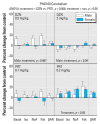Neonatal organophosphorus pesticide exposure alters the developmental trajectory of cell-signaling cascades controlling metabolism: differential effects of diazinon and parathion
- PMID: 20123610
- PMCID: PMC2831919
- DOI: 10.1289/ehp.0901237
Neonatal organophosphorus pesticide exposure alters the developmental trajectory of cell-signaling cascades controlling metabolism: differential effects of diazinon and parathion
Abstract
Background: Organophosphorus pesticides (OPs) are developmental neurotoxicants but also produce lasting effects on metabolism.
Objectives/methods: We administered diazinon (DZN) or parathion (PRT) to rats on postnatal days 14 at doses straddling the threshold for systemic signs of exposure and assessed the effects on hepatic and cardiac cell signaling mediated through the adenylyl cyclase (AC) cascade.
Results: In the liver, DZN elicited global sensitization, characterized by parallel up-regulation of AC activity itself and of the responses to stimulants acting at beta-adrenergic receptors, glucagon receptors, or G-proteins. The effects intensified over the course from adolescence to adulthood. In contrast, PRT elicited up-regulation in adolescence that waned by adulthood. Superimposed on these general patterns were effects on glucagon receptor coupling to AC and on responses mediated through the Gi inhibitory protein. The effects on the liver were more substantial than those in the heart, which displayed only transient effects of DZN on AC function in adolescence and no significant effects of PRT. Furthermore, the hepatic effects were greater in magnitude than those in a brain region (cerebellum) that shares similar AC cascade elements.
Conclusions: These findings indicate that OPs alter the trajectory of hepatic cell signaling in a manner consistent with the observed emergence of prediabetes-like metabolic dysfunction. Notably, the various OPs differ in their net impact on peripheral AC signaling, making it unlikely that the effects on signaling reflect their shared property as cholinesterase inhibitors.
Figures




References
-
- Barker DJP. The developmental origins of adult disease. Eur J Epidemiol. 2003;18:733–736. - PubMed
-
- Casida JE, Quistad GB. Organophosphate toxicology: safety aspects of nonacetylcholinesterase secondary targets. Chem Res Toxicol. 2004;17:983–998. - PubMed
-
- Curtin BF, Pal N, Gordon RK, Nambiar MP. Forskolin, an inducer of cAMP, up-regulates acetylcholinesterase expression and protects against organophosphate exposure in neuro 2A cells. Mol Cell Biochem. 2006;290:23–32. - PubMed
-
- Eskenazi B, Rosas LG, Marks AR, Bradman A, Harley K, Holland N, et al. Pesticide toxicity and the developing brain. Basic Clin Pharmacol Toxicol. 2008;102:228–236. - PubMed
-
- Gao XM, Agrotis A, Autelitano DJ, Percy E, Woodcock EA, Jennings GL, et al. Sex hormones and cardiomyopathic phenotype induced by cardiac β2-adrenergic receptor overexpression. Endocrinology. 2003;144:4097–4105. - PubMed
Publication types
MeSH terms
Substances
Grants and funding
LinkOut - more resources
Full Text Sources
Medical

